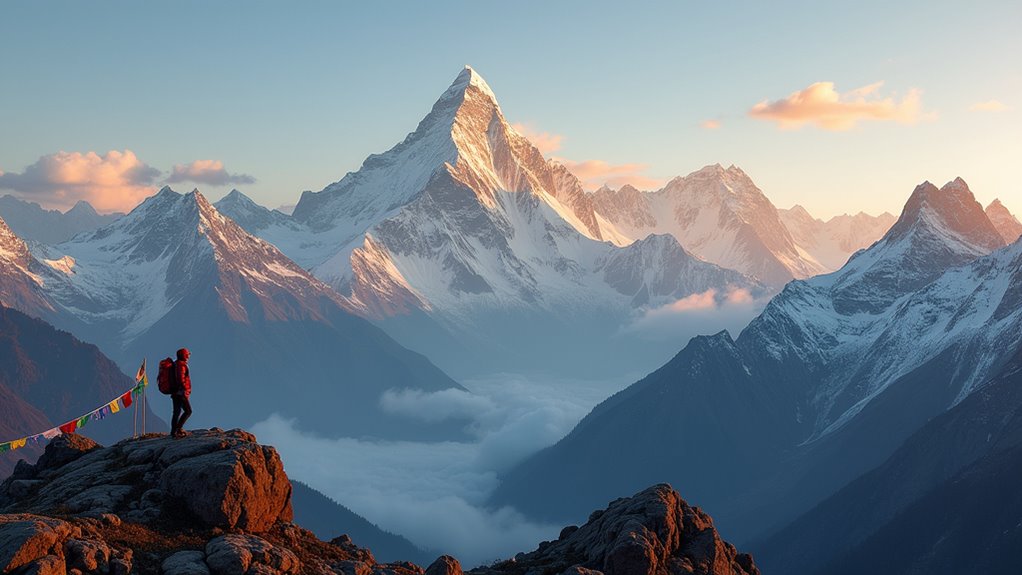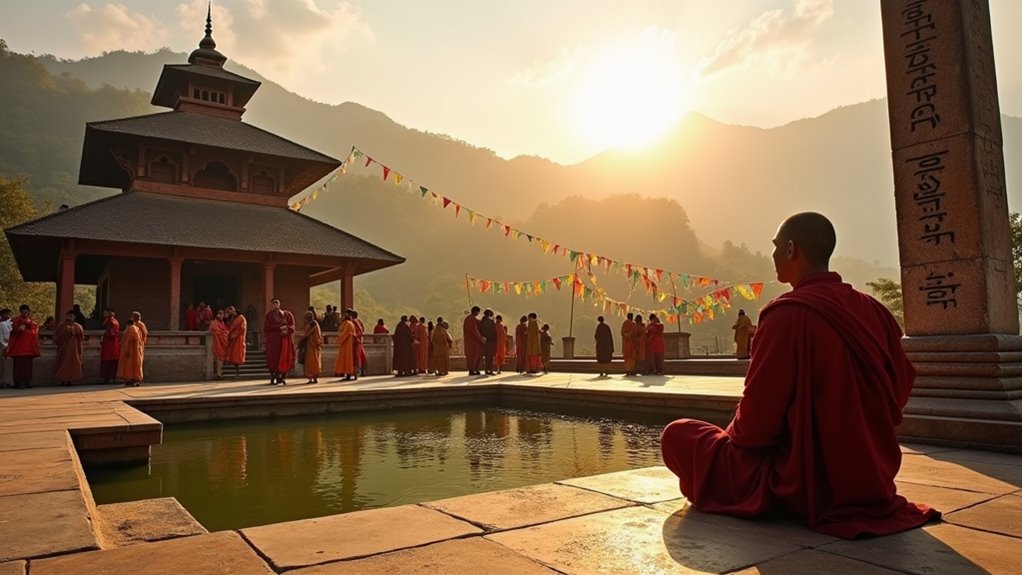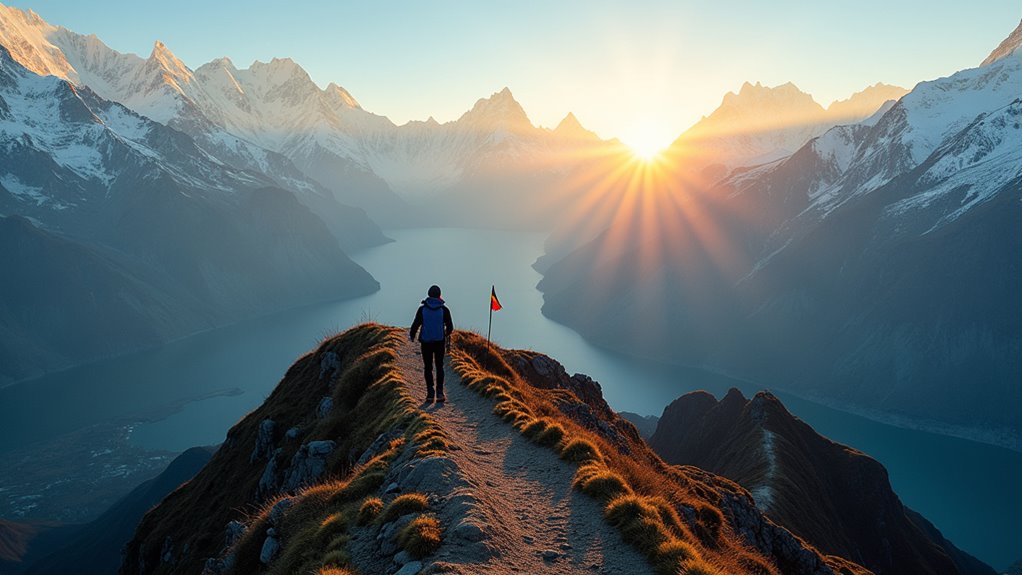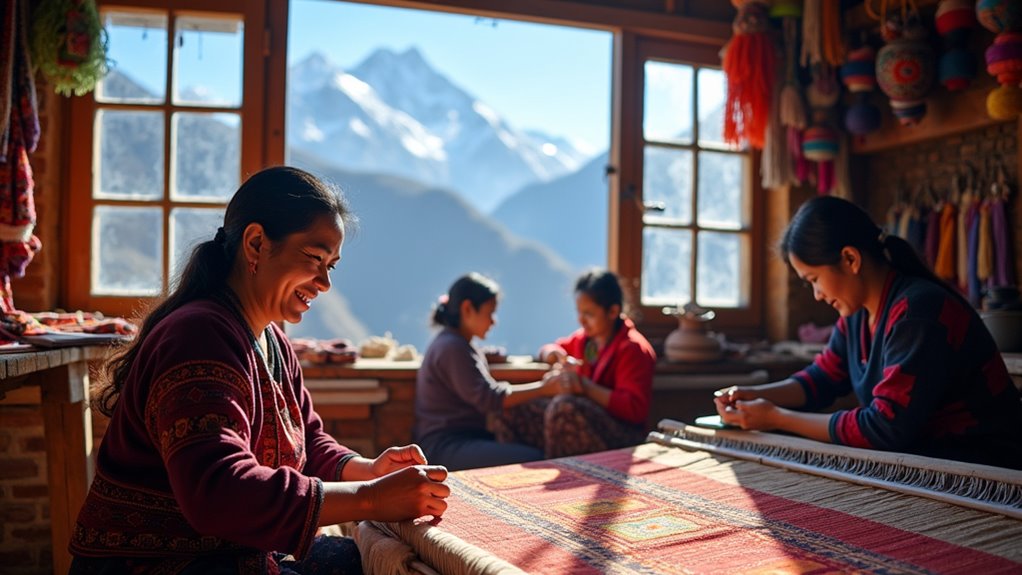Physical Address
304 North Cardinal St.
Dorchester Center, MA 02124
Physical Address
304 North Cardinal St.
Dorchester Center, MA 02124

Magnificent Nepal offers nine extraordinary reasons to visit, from towering Himalayan peaks to ancient temples that will transform your travel bucket list.
Nepal is absolutely worth visiting for its unparalleled diversity. You’ll experience the world’s highest peaks including Everest, explore Buddha’s birthplace at Lumbini, and wander UNESCO heritage sites in Kathmandu Valley. The country offers budget-friendly adventures from jungle safaris to Himalayan treks, vibrant cultural festivals, and rare wildlife encounters. Your tourism dollars directly support local communities through sustainable initiatives. These nine unique elements combine to create one of travel’s most rewarding destinations.

Why do thousands of adventure seekers flock to Nepal each year? The answer stands tall at 8,848.86 meters – Mount Everest, locally known as Sagarmatha. As the world’s highest peak, it marks the border between Nepal and China, offering two main climbing routes for the ambitious.
You don’t need to be a climber to appreciate Nepal’s mountainous majesty. The southeast route from Nepal attracts more visitors, with over 9,156 summits compared to 3,728 from Tibet.
The Sherpa people have made this possible with 6,623 successful climbs, becoming integral to both the mountain’s culture and economy.
While climbing presents serious challenges including altitude sickness and unpredictable weather, even viewing these majestic Himalayan giants from a distance is worth the journey. Mount Everest continues to slowly gain height each year due to ongoing tectonic activity, making it a constantly evolving natural wonder.
While Mount Everest dominates conversations about Nepal, the country’s true marvel lies in its astonishing geographical diversity compressed into just 147,181 square kilometers. You’ll experience three distinct regions within a relatively short distance: the tropical Terai with its lush rainforests and wildlife reserves, the rolling hills with terraced farms and river valleys, and the majestic Himalayas with alpine meadows and glaciers.
This dramatic elevation change creates remarkable climate variations, from subtropical jungles to polar-like conditions at higher altitudes. You can trek through alpine meadows in the morning and explore tropical forests by evening. The elevation ranges from less than 100 meters in the Terai lowlands to over 8,000 meters at Mount Everest’s peak. Each landscape supports unique ecosystems, traditional livelihoods, and cultural practices.
Whether you’re seeking wildlife safaris in Chitwan, paragliding in Pokhara, or exploring remote mountain villages, Nepal’s diverse topography offers an unparalleled range of experiences.

Beyond Nepal’s spectacular landscapes lies its profound spiritual heritage, embodied in Lumbini, the birthplace of Siddhartha Gautama—who became the Buddha. This UNESCO World Heritage site in the southern Terai plains offers a deeply moving experience for both Buddhists and cultural travelers.
At Lumbini, you’ll discover the sacred Maya Devi Temple marking the exact birthplace, the ancient Ashoka Pillar from 249 BCE with its Pali inscription, and the peaceful Shakya Tank.
Standing in Lumbini’s sacred grounds, you witness where history and spirituality converge at the Maya Devi Temple, ancient Ashoka Pillar, and serene Shakya Tank.
The archaeological complex contains monasteries and stupas spanning from the 3rd century BCE to the 15th century CE.
As one of Buddhism’s four most important pilgrimage destinations, Lumbini continues to attract devotees worldwide. When you visit, you’re not just touring historical ruins—you’re walking in the footsteps of one of humanity’s most influential spiritual teachers.
Visitors can also explore nearby Kapilavastu, located approximately 30 km away, which served as Buddha’s childhood home until he left at age 29.
The Kathmandu Valley cradles Nepal’s most affluent concentration of UNESCO World Heritage Sites, offering you an unparalleled glimpse into the nation’s artistic and spiritual legacy.
You’ll discover three magnificent Durbar Squares—Kathmandu, Patan, and Bhaktapur—each showcasing former royal palaces and temples with intricate Newar craftsmanship. These remarkable structures feature exceptional ornamentation crafted in brick and timber with elaborate carvings adorning windows, doorways, and roof struts. Don’t miss the iconic Buddhist stupas: ancient Swayambhunath with its panoramic city views and massive Boudhanath with its watchful Buddha eyes.
For Hindu heritage, visit sacred Pashupatinath Temple along the Bagmati River and Changu Narayan, Nepal’s oldest temple dating to the 4th century. These sites blend architectural styles while preserving living traditions through ongoing rituals and festivals.
Each monument tells a distinct chapter of Nepal’s religious harmony and artistic excellence, making the valley an essential destination for cultural enthusiasts.

Nepal’s Himalayan landscape presents you with some of the world’s most extraordinary trekking experiences, from the iconic Everest Base Camp journey to the culturally affluent Tamang Heritage Trail.
The Annapurna Circuit offers diverse scenery, while Manaslu and Kanchenjunga provide remote, less-traveled paths for adventurous souls.
Beyond trekking, you’ll find adrenaline-pumping activities throughout the country. The region’s potential for expansion into rock and ice climbing, white water rafting, mountain biking, and other adventure activities makes it an increasingly diverse adventure destination. Paraglide above Pokhara with Annapurna views, navigate thrilling rapids on the Trishuli River, or try bungee jumping near Kathmandu.
Rock climbing enthusiasts can test their skills on Himalayan faces, while zip lining offers a different perspective of Nepal’s dramatic terrain.
Most trekking routes feature teahouse accommodations and require permits, with guided tours recommended for safety in remote areas. Emergency services are available, though accessibility varies by location.
While famous for its mountains, Nepal’s protected national parks offer extraordinary wildlife encounters you won’t find elsewhere. The country’s 12 national parks protect iconic species like the Bengal tiger, one-horned rhinoceros, and Asian elephant across diverse ecosystems.
In higher elevations, you might spot the elusive snow leopard or blue sheep, while subtropical regions host sloth bears and gharials. Birdwatchers will appreciate the vibrant Himalayan Monal, Nepal’s national bird, among countless other species. Nepal is home to the spiny babbler, the only bird species endemic to the country.
Conservation efforts involve local communities and international collaboration, ensuring these habitats remain pristine. From rhododendron forests to freshwater ecosystems, each protected area showcases unique ecological diversity.
Whether you’re tracking red pandas in mountain forests or observing rare aquatic species in wetlands, Nepal’s wildlife offerings rival its mountainous fame.

Beyond stunning landscapes and wildlife, Nepal’s vibrant cultural festivals offer you an unparalleled window into one of the world’s most diverse cultural tapestries.
Dashain and Tihar, Nepal’s largest celebrations, immerse you in ancient rituals honoring Hindu deities, while the colorful Holi festival transforms streets into joyful paint-splashed gatherings each spring. If you time your visit right, you’ll witness Losar (Tibetan New Year) or the mesmerizing three-day Tiji Festival in Mustang.
These aren’t merely tourist attractions but living traditions where families reunite, communities strengthen bonds, and centuries-old customs continue. During Dashain, families gather for the special Tika ceremony on the tenth day, receiving blessings from elders. You’ll experience traditional foods prepared only during festivals, witness intricate religious ceremonies, and enjoy folk performances that showcase Nepal’s affluent ethnic diversity—all authentic expressions of a cultural heritage preserved through generations.
Traveling on a modest budget doesn’t mean compromising on authentic experiences in Nepal, where your dollar stretches remarkably far compared to most destinations. For just $20-$30 daily, you can cover accommodation, meals, and transportation while enjoying local culture.
Nepal offers exceptional value for budget travelers, delivering authentic cultural experiences without breaking the bank.
Stay in family-run guesthouses for $5-$15 per night, enjoy traditional Nepali dishes at local eateries for $2-$5, and navigate between towns on public buses for mere cents. Nepal ranks in the top 10% globally for affordability, making it an exceptional value destination.
A two-week adventure typically costs around $615 excluding international flights.
UNESCO World Heritage Sites, ancient temples, and vibrant markets are accessible with minimal entry fees. The country’s affordability extends to meaningful cultural exchanges—homestays connect you directly with local families, while village visits and walking tours often operate on donation bases, making authentic experiences available regardless of budget.

Nepal offers more than just budget-friendly adventures—it’s a leader in sustainable tourism that genuinely benefits local communities. When you trek through regions like Annapurna or Manaslu, you’re supporting community-managed ecotourism projects where locals participate as planners, hosts, and guides, ensuring tourism income stays within their villages.
Your travel dollars directly contribute to:
The eco-trekking market is booming, projected to reach $1.14 billion by 2035, proving sustainable tourism isn’t just ethical—it’s economically viable. This growing emphasis on sustainable tourism initiatives aligns perfectly with Nepal’s market trends as the country continues to promote responsible travel experiences.
You’ll return from Nepal with empty pockets but a full heart—and several Instagram posts that’ll make colleagues seethe with envy. Sure, you “found yourself” between oxygen-deprived hikes and temple visits, but let’s be honest: you’re supporting an economy that desperately needs tourism dollars. So book that flight—your enlightenment awaits, along with countless locals ready to sell you prayer flags.